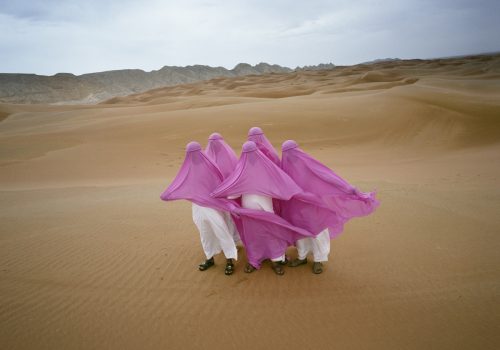Pictures from isolated places, scenes often created together with the inhabitants where the vast surreal nature is used as a backdrop. In the art of Scarlett Hooft Graafland, who travels alone with just a backpack and a camera, the circumstances that present themselves on site defines the work. Often full of contradictions that unfold the drama … The exhibition Vanishing Traces at Fotografiska will leave everlasting marks.
For Dutch artist and photographer Scarlett Hooft Graafland the ever changing nature is her focal point to which she adds encounters with cultures from all over the world. It is fascinating how she, sometimes after weeks of preparations together with the inhabitants, manage to capture those meetings between her own imagination, nature and the people living in this often very remote areas. The result: pieces of art that leaves no eternal trace but make an ever- lasting impact on the observer, raising essential questions created by those vanishing traces. No matter if it is a big tree full of the women from a tribe, fisherman like captured fishes at the bottom of their boats or balloons carried by women in burkas, all parts of the exhibition Vanishing Traces at Fotografiska.
“I like to work with the circumstances that present themselves on site. That is what defines the work, and limits it as well. Like its subject,
the elements of the performance change and transform over time; the fishermen store their canoes, ice blocks melt and balloons drift away.
I really like to use strange elements in the landscape that somehow has a connection but on the other hand look very strange.”
Hooft Graafland, trained in sculpture, started her career as a performance artist who took photos of her installations, photos that are now the central part of her art. The contradictory is amplified by the use of minimalism and contrast; by tiny figures and immense surroundings and expanses, delineated figures and boundless skies and horizons, sharp colors within a natural uni- form landscape, composition and indeterminacy, open and vulnerable versus closed and covered, culture versus nature.
“It’s impressing the impact Scarlett Hooft Graafland works has. Despite the heavy themes the result of the projects are always light, colourful and lustful scenes. She works totally analog using the natural light and an analog camera capturing the staged often surrealistic scenes. We are very happy and proud to here present Vanishing Traces that includes work never showed before”, tells Jessica Jarl, Exhibition Producer at Fotografiska International.
The way Hooft Graafland travels is as a backpacker alone to the most isolated corners on earth, to the salt desert of Bolivia, the desolate Canadian arctic, and remote islands such as Madagascar, Socotra (Yemen), Iceland and Vanuatu. These austere surroundings become live actors in the highly choreo- graphed performances that Hooft Graafland stages there. On stage, the actor is usually surrounded by a vast surreal landscape, which becomes the chorus of a classical tragicomedy, silently commenting on the drama that unfolds.
“The people living in these remote places, who live so much closer to nature than most of us, are very helpful to cooperate and create the scenes with props that are available. It can take some time to build trust, but often they feel sorry for me traveling on my own and they invite me, and then I invite them to help me create the theme of the picture.”
Clashes of cultural contexts and shapes. Harmony and conflict walks hand in hand in her photography as pairs of contradictions and similarity, that makes such a strong impact placed together.
If you for example have seen the Burka Balloons you will never forget it. These women who lives on Socotra, an island outside Yemen, are dressed in burkas walking on the beach carrying long big white balloons. Pointing out cultural behaviour where local social customs and traditions take center stage motivated by seemingly timeless values like honor, virtue and eternal bliss. One example of a Hooft Graafland-scene, where the actor is usually sur- rounded by a vast surreal landscape, which becomes the chorus of a classical tragicomedy, silently commenting on the drama that unfolds. All very beauti- fully composed.
“It would never have worked with ordinary round balloons, as a sculptor I always look for shapes and these balloons had a similarity to the silhouettes of the women carrying them. The women thought it was
a funny idea and the combination of those two parts create a humours touch that also catches the observer. My point is that the culture often minimize what could have been grand, as grand as the nature.”
The same with the fishermen stuck at the bottom of their boat referring to
the fact that there is almost no fish left to capture in the sea. It looks funny and are carrying a strong question mark: what is happening with the resources nature brings when us humans treats them like there was no tomorrow, putting everlasting destructive marks …
The friction between nature and culture – visual poetry that show beauty but also has an edge. Hooft Graafland makes an impact with her gift of putting things in a different perspective.
Scarlett Hooft Graafland – Vanishing Traces
24.5–1.9 2019
Fotografiska
Stadsgårdshamnen 22
116 45 Stockholm
















